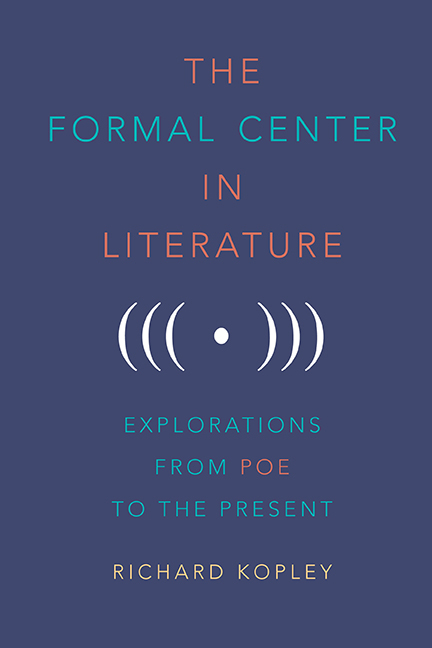Book contents
- Frontmatter
- Dedication
- Contents
- Acknowledgments
- Introduction
- 1 “Mournful and Never-Ending Remembrance” in Edgar Allan Poe's The Narrative of Arthur Gordon Pym
- 2 Retracing Our Steps in Edgar Allan Poe's “The Man of the Crowd”
- 3 “Scrutinizing the Parchment More Closely”: The Form of “The Gold-Bug” and Its Relationship to That of the Dupin Tales
- 4 Form and Reform in Nathaniel Hawthorne's “Earth's Holocaust”
- 5 The Circle and Its Center in Herman Melville's “Bartleby, the Scrivener”
- 6 Chiasmus in Henry David Thoreau's Walden
- 7 The Mythological Centers of Lewis Carroll's Alice Books
- 8 Table as Text in James Joyce's “The Dead”
- 9 The Structure of Sherwood Anderson's “Hands”
- 10 The Architecture of Ernest Hemingway's “The Three-Day Blow”
- 11 Balance in Dashiell Hammett's The Maltese Falcon
- 12 Framing Caesar in Raymond Chandler's The Big Sleep
- 13 The Ridge of the Domino in Patricia Highsmith's Strangers on a Train
- 14 The “X in the Air” in Joyce Carol Oates's “Where Are You Going, Where Have You Been?”
- 15 The Hybrid Center of Zadie Smith's White Teeth
- Notes
- Bibliography
- Index
12 - Framing Caesar in Raymond Chandler's The Big Sleep
Published online by Cambridge University Press: 14 June 2019
- Frontmatter
- Dedication
- Contents
- Acknowledgments
- Introduction
- 1 “Mournful and Never-Ending Remembrance” in Edgar Allan Poe's The Narrative of Arthur Gordon Pym
- 2 Retracing Our Steps in Edgar Allan Poe's “The Man of the Crowd”
- 3 “Scrutinizing the Parchment More Closely”: The Form of “The Gold-Bug” and Its Relationship to That of the Dupin Tales
- 4 Form and Reform in Nathaniel Hawthorne's “Earth's Holocaust”
- 5 The Circle and Its Center in Herman Melville's “Bartleby, the Scrivener”
- 6 Chiasmus in Henry David Thoreau's Walden
- 7 The Mythological Centers of Lewis Carroll's Alice Books
- 8 Table as Text in James Joyce's “The Dead”
- 9 The Structure of Sherwood Anderson's “Hands”
- 10 The Architecture of Ernest Hemingway's “The Three-Day Blow”
- 11 Balance in Dashiell Hammett's The Maltese Falcon
- 12 Framing Caesar in Raymond Chandler's The Big Sleep
- 13 The Ridge of the Domino in Patricia Highsmith's Strangers on a Train
- 14 The “X in the Air” in Joyce Carol Oates's “Where Are You Going, Where Have You Been?”
- 15 The Hybrid Center of Zadie Smith's White Teeth
- Notes
- Bibliography
- Index
Summary
DASHIELL HAMMETT's admiring successor, Raymond Chandler, wrote vividly in “The Simple Art of Murder” about his predecessor's reconceiving the elegant English mystery for the realistic American one: “Hammett took murder out of the Venetian vase and dropped it into the alley.” Focusing on Hammett's most celebrated work, Chandler added, “The Maltese Falcon may or may not be a work of genius, but an art which is capable of it is not ‘by hypothesis’ incapable of anything. Once a detective story can be as good as this, only the pedants will deny that it could be even better.” Whether Chandler's first novel, The Big Sleep, is better than The Maltese Falcon has not been resolved, but that the two works feature strong resonances, from the sinister city to the tough-guy detective, is clear. What may be demonstrated here more specifically is that the form that Hammett elaborated for The Maltese Falcon—the verbal symmetry with the significant center—was ably re-elaborated by Chandler in The Big Sleep. Perhaps, then, even as the detective, according to Chandler, is “in search of a hidden truth,” so, too, may his reader seek—and find—a hidden literary pattern.
Chandler came to detective fiction not through work for a detective agency but through work for an oil company. He wrote short stories for the detective fiction pulp magazine Black Mask and refashioned several of these (especially the 1935 “Killer in the Rain” and the 1936 “The Curtain”) and built on them for The Big Sleep. Not surprisingly, given Chandler's background, the story concerns an old oil man, General Guy Sternwood. Sternwood hires Philip Marlowe to track down blackmailer Arthur Gwynn Geiger, and the detective eventually finds himself tracking down Carol Lundgren, who had killed a man whom Lundgren thought had killed Geiger. Marlowe comes to understand and deal with the controlling power, the smooth casino operator Eddie Mars (and his hit-man, the deadly Mr. Canino), as well as the treacherous and seductive Sternwood daughters, Carmen and Vivian. What Mars has on Vivian, Marlowe realizes, is knowledge of her having covered up her sister Carmen's murder of Vivian's third husband, the mysterious Rusty Regan. If the plot is complicated, it is also briskly rendered, with crisp dialogue and crackling similes. And the book offers a notable symmetry.
- Type
- Chapter
- Information
- The Formal Center in LiteratureExplorations from Poe to the Present, pp. 99 - 106Publisher: Boydell & BrewerPrint publication year: 2018



